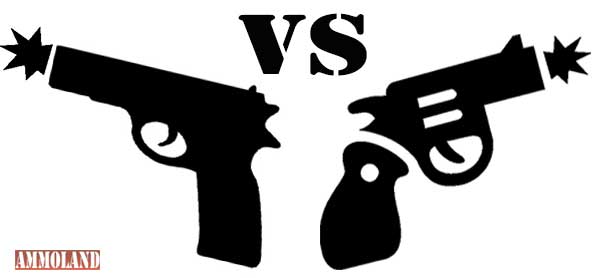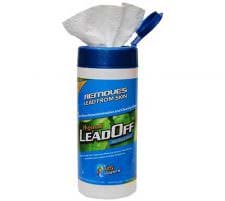By David Tong


USA -(AmmoLand.com)- I would like to preface this by stating at the outset that this is my opinion, after having used both types of handguns for nearly four decades.
The revolver is largely a 19th Century creation. Other than the creation of the double-action lockwork and a side-plate-less frame (thanks, Ruger), the inherent technology of the revolver pre-dates the Civil War.
Single & Double Action Revolver
Proponents of the revolver usually state that their outward simplicity to make them work, as opposed to their internal complexity of operation, is one of their key points. They will nearly always say “Six shots for sure,” as nearly a mantra when they compare them to self-loaders as “jamamatics.”
Revolvers comprise a revolving cylinder, bored through with five to ten cartridge chambers, rotating about a central axle. This is mounted into a frame or receiver. This cylinder is rotated into place by an advancing hand, which contacts small machined pads on the rear of the cylinder to precisely rotate the cylinder from chamber center to firing pin center of the hammer, repeatedly with each cocking of a hammer or pull of the trigger (in the case of a double-action revolver).
Cylinder rotation is stopped by a spring loaded bolt, which is also usually timed by trigger motion, so that chambers containing the rounds are precisely indexed in line with the fixed barrel, and thus will not shave bullet or jacket material due to off center impacts with the rear of the barrel. There is nearly always a gap between cylinder face and rear of the barrel called the “barrel-cylinder gap.” Hot gases and noise are expelled from this gap on top of the muzzle of the arm.
A revolver may be a single action, which requires a shooter to cock the hammer each time to set all these parts in motion manually, and must also be loaded and unloaded one round at a time manually as well. This is a slow and detailed process.
A double-action, swing-out cylinder revolver is slightly simpler in that all current ones allow for simultaneous extraction and ejection of the spent cases, but the opening and closing of the cylinder and punching the ejector rod is still done manually. Reloading the DA revolver can be accomplished with the use of a so-called “speedloader,” but sometimes there are alignment issues with the chambers of the revolver, and sometimes the grips get in the way of placing the speedloader in position, or to make ejection of the spent cases difficult due to their shape behind the cylinder’s rear.
Primarily though, a revolver can be quite reliable if all of those interacting pieces are made of superior metals, of superior heat-treatment, but the shooter is still responsible for making them work.

Revolvers used to primarily use lead bullets both in military and police service, as well as for civilian match shooting. Cowboy action shooters still do use them.
Lead is of course a toxic material, and leaves much residue if it is of a softer alloy lower in tin content.
This can cause barrel fouling, and the face of the cylinder can often be found caked with both lead and powder residue that must periodically be cleaned to ensure that the barrel-cylinder gap is still sufficient to allow free turning of the cylinder in order to function correctly, Moreover, one has to clean each individual chamber, the rear face of the cylinder where the ratchet pads are, as well as scrub the rear face of the frame where the advancing hand and firing pin holes can also be partially blocked by residue.
Thus, while the revolver is outwardly simple, the need for mechanical complexity and user operation ease are nearly polar opposites. Typically, a revolver shooting modern jacketed bullets can be shot 1,000-1,500 rounds before needing a decent cleaning, and they would be completely reliable to that round count for the most part.
The primary advantage, to me, of the revolver, is that it can be loaded with cartridges of greatly varying bullet weights and pressure curves. Thus, a .38 or .44 Special with their mild noise levels and recoil can be used for training and precision target shooting, while the .357 and .44 Magnum rounds can be used for hunting and self-defense against large animals or dumb criminals.
Semi-Automatic Pistol
In contrast though, the semi-automatic pistol has replaced the revolver for nearly all uses besides hunting big game (deer-sized, anyway, or protection from large carnivores such as bears or cougars). The reasons are many, but they can be distilled thusly.
First, the semi-automatic pistol is the product of the development of both smokeless powder and the jacketed bullet. Higher pressures are possible, and the jacketed bullets designed with their handguns from the outset mean that they run typically cleaner. Having only one chamber which is machined integrally with the rifled tube means there’s less to clean.
Secondly, the semi-automatic’s internal complexity is designed to have the shooter work LESS hard to make his/her handgun function. When the trigger is pressed, a hammer strikes a firing pin, or a striker falls to hit a primer, the round is discharged. After pressures have dropped, the semi-auto’s slide moves backward under gas pressure, and the empty case is simultaneously extracted and ejected automatically. Reloading is accomplished by the slide returning into battery after stripping a round from the top of the detachable magazine, and usually a semi-auto holds at least six rounds, and up to twenty or more.
When the shooter needs to replenish the magazine, a spring loaded button is depressed, the magazine falls free, and in one stroke a loaded one is replaced.
Third, the straight-line action of the semi-auto pistol can promise even greater reliability than the revolver. Indeed, most of us have read the stories of how 1911, Glock, and HK pistols have shot many thousands of rounds without even a basic cleaning. The late Todd Green (of pistol-training.com) conducted a test of the Heckler and Koch HK45 pistol several years back, firing some 50,000 rounds through his pistol in eight months. The pistol had ONE malfunction, ONE trigger bar return spring replacement, and averaged 7,000+ rounds between cleanings during the test. The recoil spring and magazine springs were not replaced, and the pistol shot equally tight groups at the end as it did at the beginning, while all the rounds save 120 were full-power police service loads.
This is well-beyond the kind of use most of us will put through either a revolver or semi-auto handgun in our lifetime, but it illustrates that the old saw about “six for sure” isn’t really accurate any longer.
I have personally shot more than 1,000 hard linotype target bullets through a 1911 pistol several times, and had no issues at all. The one weakness in the semi-auto pistol is the quality of the magazine and its feed geometry though. It MUST be made of quality materials, and it MUST offer up the top round in a predictable and slightly nose-high attitude to best provide as straight a path to the chamber as possible (and bypassing the feed ramps as much as possible). Most quality magazines can be had in the $20-45 range, so they won’t break the bank of anyone who just laid out $500+ for their handgun.
While I do have remaining reservations about the very small micro-compact auto pistols’ reliability versus a snub revolver used at very close ranges, even this may be overplayed by “round-gun” aficionados. Modern computed aided design and machining has pretty much put-paid to malfunctions of even the small semis if built by a Tier One level quality manufacturer.
It is my view that as (primarily) a defensive tool, a semi-automatic has much to recommend it because it can be equally reliable if not more so, in extremis. I don’t believe I am alone in this assessment either, as a visit to your local gun store will show that the handguns that are primarily purchased these days are the semi-automatics.
Please do not let this be a blanket endorsement of the overall superiority of the semi-automatic. It is not. It is simply my opinion, even if borne out by decades of experience.
There are some purposes alluded to above where the revolver’s user simplicity, ammo power flexibility, and potentially-wider usage is compelling. They both have a place.
